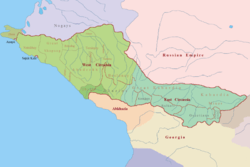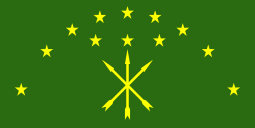Circassians in Israel
| Адыгэхэу Исраэл исыхэр הצ'רקסים בישראל | |
|---|---|
|
| |
| Total population | |
| c. 4,000[1][2]–5,000[3] | |
| Regions with significant populations | |
| Kfar Kama, Rehaniya | |
| Languages | |
| Hebrew, Circassian, English, Arabic | |
| Religion | |
| Sunni Islam | |
| Related ethnic groups | |
| Other Circassians |
| Part of a series on |
| Islam |
|---|
 |
|
Related topics |
|
Circassians in Israel (Adyghe: Адыгэхэу Исраэл исыхэр; Hebrew: הצ'רקסים בישראל) refers to the Circassian people who live in Israel.
Circassians in Israel are Sunni Muslims, and number about 4,000 and live primarily in two towns: Kfar Kama (Adyghe: Кфар Кама) and Rehaniya (Adyghe: Рихьаные). They are one of three minority groups in Israel drafted into the Israel Defense Forces (IDF).
History


The Circassians arrived in the Middle East after they were expelled from their homeland in the northwestern Caucasus. The Circassians, who fought during the long period (see the Russian-Circassian War) wherein the Russians captured the northern Caucasus, were massacred and expelled by Czarist Russia from the Caucasus. The Ottoman Empire, which saw the Circassians as experienced fighters, absorbed them in their territory and settled them in sparsely populated areas, including the Galilee.[4]
The Circassian exiles established Rehaniya in 1873, and Kfar Kama in 1876.[5]
The Circassian community in Israel is well integrated into Israeli society. They speak both Adyghe and Hebrew, and many also speak Arabic and English, while cultivating their unique heritage and culture.[6]
Israeli Circassians have had good relations with the Jewish community in Israel since the beginning of the pre-state Jewish settlement in the Land of Israel, in part due to the language shared with many of the First Aliyah immigrants from Russia who settled in the Galilee. The Circassian community in Israel helped the illegal migration of Jews from Lebanon into Mandate Palestine. Circassians fought on the Israeli side of the War of Independence. At their community leaders' request, since 1958 all male Circassians must complete the mandatory military service in the Israel Defense Forces upon reaching the age of majority, while females do not.[7] In this, they are equal to the Israeli Jews and the Israeli Druze populations living in the State of Israel proper (this excludes the Druze population living on the Golan Heights.) The percentage of the army recruits among the Circassian community in Israel is particularly high. Many Circassians also serve in the Israel National Police, Israel Border Police, and the Israel Prison Service.

In 1976, the Circassian community won the right to maintain its own educational system separate from the Israeli government's Department of Arab Affairs. As a result, the community manages its own separate educational system, which ensures that its culture is passed down to the younger generations.[8]

The Circassian community of Israel is concentrated almost entirely in the villages of Kfar Kama (population c. 3,000) and Rehaniya (population c. 1,000). In contrast to Circassian communities in other Middle Eastern countries, which have lost much of their traditions, Israeli Circassians have carefully preserved their culture. More than 90% of Circassians return to their villages after completing their military service and studies. Despite the difficulty of finding marriage partners within a community of 4,000, Israeli Circassians mostly shun intermarriage. Although some Arabs moved to Kfar Kama, they quickly integrated into local society and left no lasting cultural impression. Intermarriage is widely regarded as a taboo there. Rehaniya absorbed large numbers of internally displaced Arab refugees during the 1948 war, and as a result, intermarriage with non-Circassians, while still avoided for the most part, became more acceptable there.[9][10]
Demography
Israeli Circassians have adopted the Western practice of smaller families,[10] with an average of two children per family,[10] compared to the national rate of 3.73 children per family.[10]
Circassian families in Israel
- Abrag (Adyghe: Абрэгь)
- Ashmuz or Achmuzh (Adyghe: Ачъумыжъ)
- Bat (Adyghe: Бат)
- Batwash (Adyghe: БэтIыуашъ)
- Bghana (Adyghe: Бгъанэ)
- Blanghaps (Adyghe: БлэнгъэпсI)
- Choshha or Shoshha (Adyghe: Чъушъхьэ)
- Gorkozh (Adyghe: ГъоркIожъ)
- Hadish (Adyghe: Хьэдищ)
- Hako or Hakho (Adyghe: Хьэхъу)
- Hazal (Adyghe: Хъэзэл)
- Kobla (Adyghe: Коблэ)
- Lauz (Adyghe: ЛъыIужъ)
- Libai or Labai (Adyghe: ЛIыпый)
- Nago (Adyghe: Наго)
- Napso (Adyghe: Нэпсэу)
- Nash (Adyghe: Наш)
- Natkho or Natcho (Adyghe: Натхъо)
- Qal (Adyghe: Къалыкъу)
- Qatizh (Adyghe: Къэтыжъ)
- Sagas or Shagash (Adyghe: Шъэгьашъ)
- Shamsi (Adyghe: Чъуэмшъо)
- Showgan (Adyghe: Шэугьэн)
- Shaga (Adyghe: Шъуагьэ)
- Thawcho (Adyghe: Тхьэухъо)
- Zazi (Adyghe: Зази)
Notable people
- Bibras Natkho – Israeli-Circassian footballer, who plays as a midfielder for CSKA Moscow and the Israel national team
- Izhak Nash - Israeli-Circassian footballer who plays at the Israeli Premier League
- Nili Natkho – late Israeli-Circassian basketball player who played for Maccabi Raanana and Elitzur Ramla
See also
References
- ↑ Besleney, Zeynel Abidin (2014). The Circassian Diaspora in Turkey: A Political History. Routledge. p. 96. ISBN 978-1-317-91004-6.
- ↑ Torstrick, Rebecca L. (2004). Culture and Customs of Israel. Greenwood Publishing Group. p. 46. ISBN 978-0-313-32091-0.
- ↑ Louër, Laurence (2007). To be an Arab in Israel. New York City, NY: Columbia University Press. p. 20. ISBN 978-0-231-14068-3.
- ↑ The Circassians in Israel
- ↑ Circassians (in Rehaniya and Kfar Kama)
- ↑ Circassians in Israel
- ↑ www.circassianworld.com
- ↑ Circassians, Descendants of Russian Muslims, Fight for Identity in Israel
- ↑ Gilad, Moshe (5 July 2012). "A Slightly Rarefied Circassian Day Trip". Haaretz. Tel Aviv, Israel. Archived from the original on 4 April 2016. Retrieved 14 May 2016.
I assume it must be a complex and heavy costume, not exactly the latest wrinkle for the blistering Israeli summer. But a moment later, tracing a slender hourglass shape in the air, he explains that even his slim frame would not fit into a Circassian belt without some heavy dieting. 'Our traditional costume is made for a man with a hip measurement of 50 centimeters [about 20 inches],' he said. 'I couldn't wear it today. Circassian men is supposed to look different.'
- 1 2 3 4 Sedan, Gil; Westheimer, Ruth K. (2015). The Unknown Face of Islam: The Circassians in Israel. Brooklyn, NY: Lantern Books. ISBN 978-1-59056-502-5.

